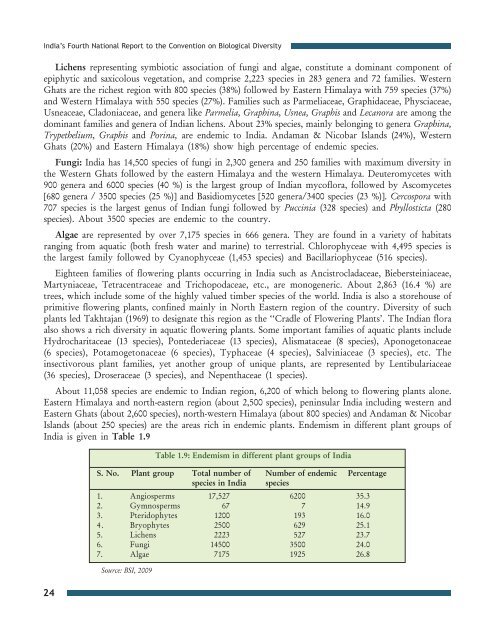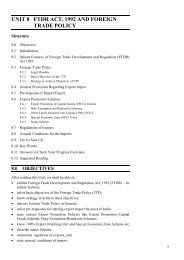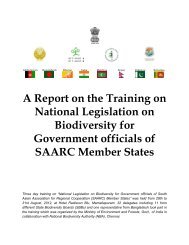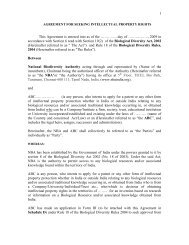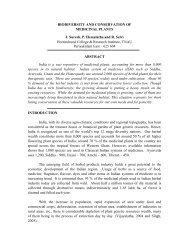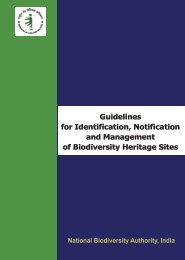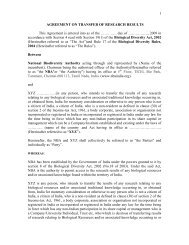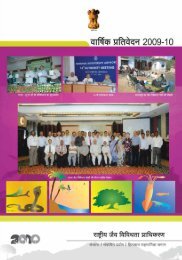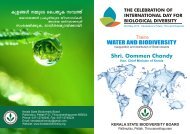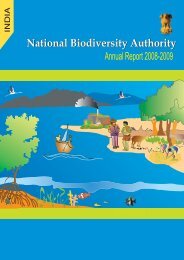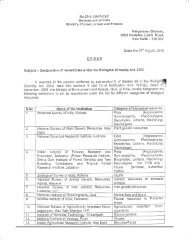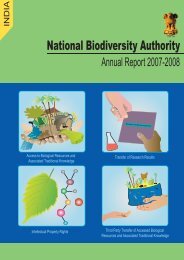Part 1 - English version (PDF) - Convention on Biological Diversity
Part 1 - English version (PDF) - Convention on Biological Diversity
Part 1 - English version (PDF) - Convention on Biological Diversity
You also want an ePaper? Increase the reach of your titles
YUMPU automatically turns print PDFs into web optimized ePapers that Google loves.
India’s Fourth Nati<strong>on</strong>al Report to the <str<strong>on</strong>g>C<strong>on</strong>venti<strong>on</strong></str<strong>on</strong>g> <strong>on</strong> <strong>Biological</strong> <strong>Diversity</strong><br />
Lichens representing symbiotic associati<strong>on</strong> of fungi and algae, c<strong>on</strong>stitute a dominant comp<strong>on</strong>ent of<br />
epiphytic and saxicolous vegetati<strong>on</strong>, and comprise 2,223 species in 283 genera and 72 families. Western<br />
Ghats are the richest regi<strong>on</strong> with 800 species (38%) followed by Eastern Himalaya with 759 species (37%)<br />
and Western Himalaya with 550 species (27%). Families such as Parmeliaceae, Graphidaceae, Physciaceae,<br />
Usneaceae, Clad<strong>on</strong>iaceae, and genera like Parmelia, Graphina, Usnea, Graphis and Lecanora are am<strong>on</strong>g the<br />
dominant families and genera of Indian lichens. About 23% species, mainly bel<strong>on</strong>ging to genera Graphina,<br />
Trypethelium, Graphis and Porina, are endemic to India. Andaman & Nicobar Islands (24%), Western<br />
Ghats (20%) and Eastern Himalaya (18%) show high percentage of endemic species.<br />
Fungi: India has 14,500 species of fungi in 2,300 genera and 250 families with maximum diversity in<br />
the Western Ghats followed by the eastern Himalaya and the western Himalaya. Deuteromycetes with<br />
900 genera and 6000 species (40 %) is the largest group of Indian mycoflora, followed by Ascomycetes<br />
[680 genera / 3500 species (25 %)] and Basidiomycetes [520 genera/3400 species (23 %)]. Cercospora with<br />
707 species is the largest genus of Indian fungi followed by Puccinia (328 species) and Phyllosticta (280<br />
species). About 3500 species are endemic to the country.<br />
Algae are represented by over 7,175 species in 666 genera. They are found in a variety of habitats<br />
ranging from aquatic (both fresh water and marine) to terrestrial. Chlorophyceae with 4,495 species is<br />
the largest family followed by Cyanophyceae (1,453 species) and Bacillariophyceae (516 species).<br />
Eighteen families of flowering plants occurring in India such as Ancistrocladaceae, Biebersteiniaceae,<br />
Martyniaceae, Tetracentraceae and Trichopodaceae, etc., are m<strong>on</strong>ogeneric. About 2,863 (16.4 %) are<br />
trees, which include some of the highly valued timber species of the world. India is also a storehouse of<br />
primitive flowering plants, c<strong>on</strong>fined mainly in North Eastern regi<strong>on</strong> of the country. <strong>Diversity</strong> of such<br />
plants led Takhtajan (1969) to designate this regi<strong>on</strong> as the ‘‘Cradle of Flowering Plants’. The Indian flora<br />
also shows a rich diversity in aquatic flowering plants. Some important families of aquatic plants include<br />
Hydrocharitaceae (13 species), P<strong>on</strong>tederiaceae (13 species), Alismataceae (8 species), Ap<strong>on</strong>oget<strong>on</strong>aceae<br />
(6 species), Potamoget<strong>on</strong>aceae (6 species), Typhaceae (4 species), Salviniaceae (3 species), etc. The<br />
insectivorous plant families, yet another group of unique plants, are represented by Lentibulariaceae<br />
(36 species), Droseraceae (3 species), and Nepenthaceae (1 species).<br />
About 11,058 species are endemic to Indian regi<strong>on</strong>, 6,200 of which bel<strong>on</strong>g to flowering plants al<strong>on</strong>e.<br />
Eastern Himalaya and north-eastern regi<strong>on</strong> (about 2,500 species), peninsular India including western and<br />
Eastern Ghats (about 2,600 species), north-western Himalaya (about 800 species) and Andaman & Nicobar<br />
Islands (about 250 species) are the areas rich in endemic plants. Endemism in different plant groups of<br />
India is given in Table 1.9<br />
Table 1.9: Endemism in different plant groups of India<br />
S. No. Plant group Total number of Number of endemic Percentage<br />
species in India species<br />
1. Angiosperms 17,527 6200 35.3<br />
2. Gymnosperms 67 7 14.9<br />
3. Pteridophytes 1200 193 16.0<br />
4. Bryophytes 2500 629 25.1<br />
5. Lichens 2223 527 23.7<br />
6. Fungi 14500 3500 24.0<br />
7. Algae 7175 1925 26.8<br />
Source: BSI, 2009<br />
24


